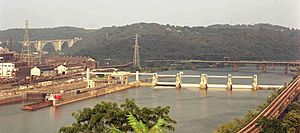- This page was last modified on 17 October 2025, at 10:18. Suggest an edit.
Braddock Locks & Dam facts for kids
| Braddock Locks and Dam | |
|---|---|
 |
|
| Location | Braddock, Pennsylvania and West Mifflin, Pennsylvania |
| Coordinates | 40°23′27″N 79°51′28″W / 40.39083°N 79.85778°W |
| Construction began | 1902 |
| Opening date | 1906 |
| Operator(s) | U.S. Army Corps of Engineers, Pittsburgh District |
| Dam and spillways | |
| Impounds | Monongahela River |
The Braddock Locks & Dam is an important structure on the Monongahela River. It used to be called Monongahela Locks and Dam No. 2. This dam is one of nine structures that help boats travel safely on the river. These structures are located between Pittsburgh, Pennsylvania and Fairmont, West Virginia.
The U.S. Army Corps of Engineers built and takes care of the Braddock Locks & Dam. It has a special gate system and a lock. This setup creates a calm pool of water upstream that stretches for about 12.6 miles (20.3 km). This pool reaches all the way to Elizabeth, Pennsylvania.
What is the Braddock Locks and Dam?
The Braddock Locks and Dam is made up of two main parts. There are the locks, which are on one side of the river. Then there is the new dam, which has special gates. This new dam replaced an older one that was almost 100 years old. The old dam was a "fixed-crest dam," meaning it was a solid wall that couldn't be opened or closed.
How the Locks Work
The locks at Braddock were built in 1953. They have two chambers, or large water-filled rooms, side-by-side. These chambers help boats move between different water levels.
- The larger chamber, called the land chamber, is 110 feet (33.5 meters) wide and 720 feet (219.5 meters) long.
- The smaller chamber, called the river chamber, is 56 feet (17.1 meters) wide and 360 feet (109.7 meters) long.
When a boat needs to go up or down the river, it enters one of these chambers. The water level inside the chamber is then raised or lowered to match the water level on the other side. This allows the boat to continue its journey.
Building the New Dam
Building the new Braddock Dam started in 1999 and finished in May 2004. The engineers used a clever method called "in-the-wet construction." This means they built large parts of the dam somewhere else. These parts were like giant hollow concrete boxes.
They floated these huge sections into place on the river. Then, they carefully lowered them onto a strong foundation. This foundation was made of metal walls and large poles drilled deep into the solid rock below the riverbed.
- The first floating section weighed about 11,600 short tons (10,523 metric tons). It was 333 feet (101.5 meters) long and 104 feet (31.7 meters) wide.
- The second section weighed about 9,000 short tons (8,165 metric tons). It was 265 feet (80.8 meters) long and 104 feet (31.7 meters) wide.
The dam's spillway, which is the part where water flows over, is 517 feet (157.6 meters) wide. It has three large gates called Tainter gates. Each of these gates is 110 feet (33.5 meters) wide and 21 feet (6.4 meters) high. There is also one smaller Tainter gate, 110 feet (33.5 meters) wide and 11 feet (3.4 meters) high, which helps manage water quality.
Each gate is moved by two powerful hydraulic cylinders. These are like strong arms that push and pull the gates. All the gates were built in Alabama and then shipped by barge to the dam site. The cost to build this new dam was about $107.4 million.
